Chatbot /
6 Min read
Top 11 Things to Look Out for in a Chatbot Builder
July 26, 2022

Hardik Makadia
CEO, WotNot
Chatbots have revamped the website engagement outlook for brands.
And rightly so — by being available 24/7, providing instant replies to customers’ common queries, and so much more.
But let’s not overlook the reason why chatbots became a phenomenon in marketing automation in the first place.
Two words: No code.
Although chatbots can be built in various ways like through code, visual builder (low code), and no-code platforms, it is the no code chatbot builder that deserves the most attention.
Gartner predicts that 66% of big companies will use a minimum of four low-code/no-code platforms by 2024.
No-code building also gives marketers and support teams a way to dictate the automation experience for the users. No-code tools provide them with the liberty to make changes by themselves without dependency on the development team.
The thing is, not all chatbot builders have the same capabilities.
If you really want to experience the ease of use, you need to consider numerous factors that will help your teams navigate the technology without a developer.
So, to join the ranks of the brands that are already making the most of intuitive chatbot solutions, you need to understand the must-have things to look out for in a chatbot builder. These include the features, integrations, and value for money that you need to consider while choosing a platform.
Let’s take a look at them.
I. Top 9 Must-have Features for Your Chatbot Builder
In your pursuit to choose the best chatbot builder, you have to consider several factors, and choosing the right pack of features is one of the critical factors. Here, we have listed the top 9 features that your chatbot builder must have.

1. Visual Flow Builder
Obviously, the very first requirement has to be a no code chatbot builder. Because let’s face it: we always strive for agility when it comes to using software tools. It’s faster to build apps without coding in a visual flow builder. This saves ample time and also makes it easier for literally anyone to build a chatbot.

A drag and drop interface is a must-have chatbot builder feature. It helps users easily get acquainted with the tool and allows them to seamlessly build chatbots for different use cases.
For example, using WotNot’s no code bot builder, you can create multiple decision trees to create a conversational flow. All you need to do is create separate blocks and connect them via nodes.
No code is the future and this is what brands will extensively look for in any automation tool. Additionally, you get a lot of flexibility to tweak your bot’s workflows based on customer feedback and chatbot performance and get your chatbot running in no time.
Also Read: The Best Chatbot Builders for 2023 [Reviews & Features]
2. Supports Multiple Channels
Omnichannel communication is clearly the need of the hour considering the endless channels that require a brand’s presence. While establishing that presence, you also need to ensure that the communication experience is consistent across channels.
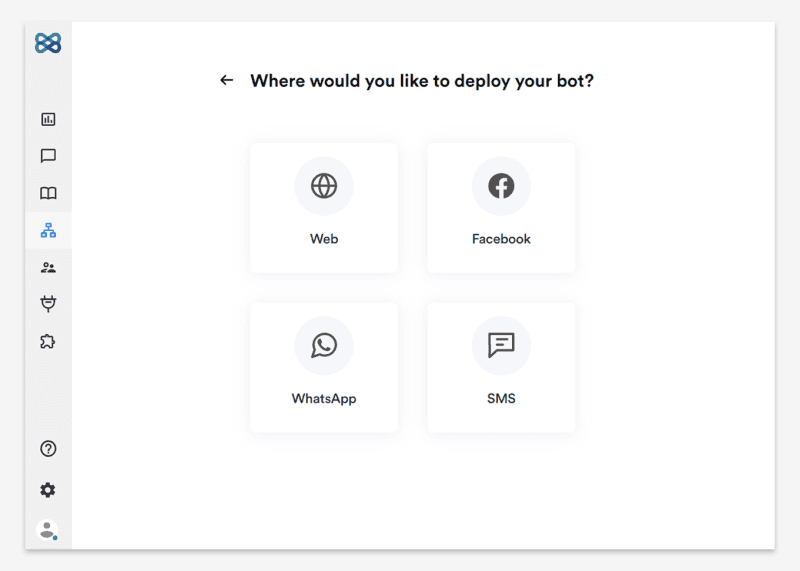
Luckily, you have numerous chatbot platform vendors that provide the option to deploy bots on multiple channels like Website, WhatsApp, SMS, and Facebook. So look for a platform where you have multiple builder options like a WhatsApp chatbot builder, open source chatbot builder, Telegram chatbot builder, etc. Also check if you can view conversations from all these channels under a single window.
On WotNot, instead of building the flow from scratch, you can simply clone your website bot and build a WhatsApp bot on a WhatsApp bot builder. You can add/remove buttons and features that are not supported by the platform and deploy the bot on WhatsApp.
This way, you can launch your omnichannel chatbot with just a click of a button instead of setting it up manually and also view the omnichannel chatbot metrics all under one platform.
3. Built-in Templates
If you’re new to using chatbots, you should know that the scripting process in chatbots needs to be strategic. It needs to be designed in a manner that fulfills your objectives.
The scripting process will also be different depending on the use cases. A lead generation chatbot flow will look very different from a customer support chatbot flow.
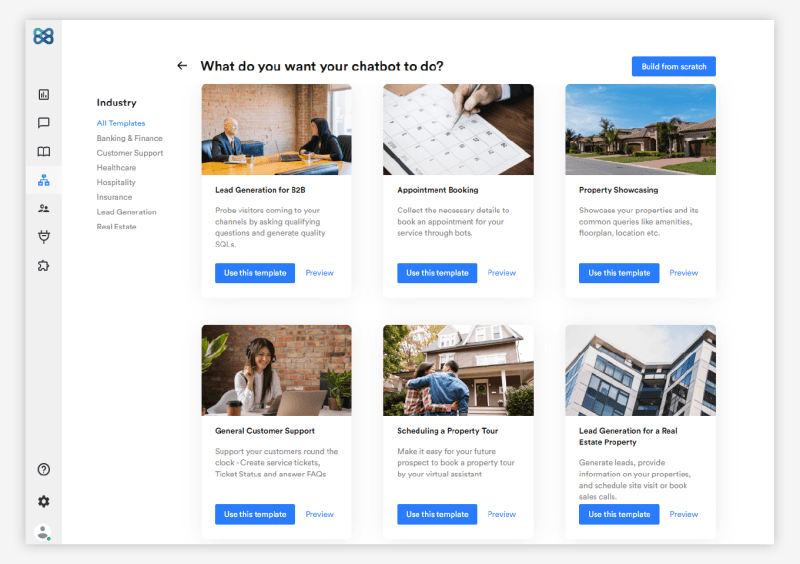
Built-in templates help you get started with the scripting process and aid you in building a flow. They give you a fair idea about the working and operational aspects of chatbots.
Chatbot builders often provide ready-made templates for different use cases. You should have the ability to use templates in the bot builder, make changes that suit your flow, and deploy the bot — all within a matter of minutes.
Also Read: How to Build a Chatbot from a Ready-made Template
4. Easy Management of Flows
A visual chatbot builder doesn’t always mean easy management of flows. Apart from the easy-to-use interface, you also need to ensure that you can manage the blocks without a hassle.
What does this management mean exactly?
The chatbot builder needs to have a fully equipped toolkit that makes bot-building self-explanatory.
You may not pay attention in case you’re building a short flow. But as your flow gets longer and more complex, you need to have the ability to move flows into sub-flows to better organize your building process. You’ll also need utility tools like minimap, auto-save, auto-layout, zoom in and zoom out, and undo-redo that’ll help you avail greater control of your bot-building process.
Additionally,once you start building your flow, you’ll have a clearer idea of what features or buttons you want to include in your blocks. Ensure that you can add a new block, replace it, or even connect them easily to follow the decision tree format and check if you can easily move the blocks around, clone bots, or delete flows altogether.
Lastly, if you’re deploying bots on multiple channels, you need to ensure the builder allows you to assemble omnichannel bots in one place. Instead of juggling multiple windows, you can manage all your bots under a single window.
5. Ability to Create Multilingual Bots
One of the distinct chatbot features is that you can communicate in the language of your consumer. No matter where you’re headquartered, you can reach different nationalities and localities using a multi-lingual bot. It removes the language barrier and brings you one step closer to your customers. It helps you grow your customer base and foster customer engagement and loyalty amongst your existing customers.
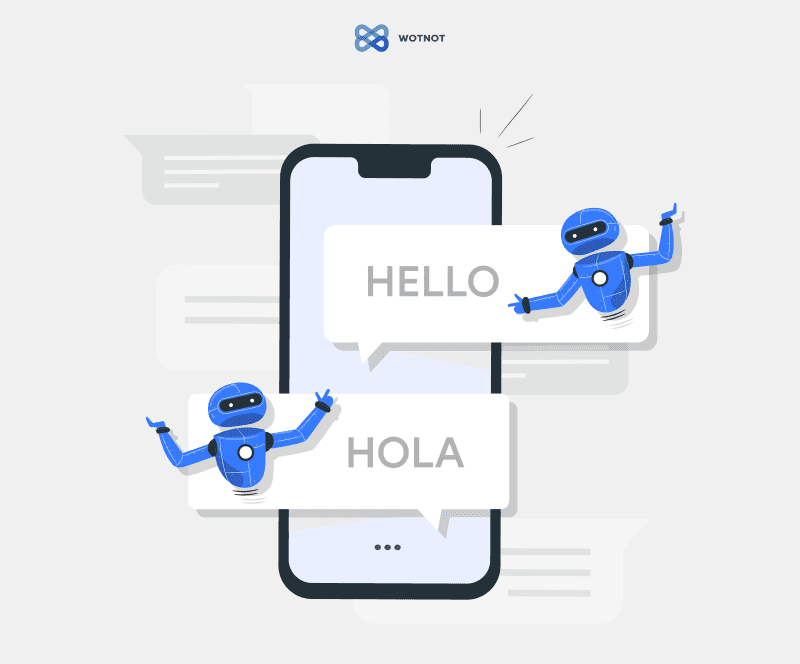
Multi-lingual bots are powered by NLP (Natural Language Processing) engines such as Google’s Dialogflow and IBM Watson. Engines like Dialogflow provides an option to build chatbots in 20 different languages. The engines are also backed by machine learning capabilities.
If you want to build multilingual bots on your chatbot builder, check for NLP integrations. NLP engines will take nuances of language and meaning to account to provide accurate replies in multiple languages.
6. Version Controls
Your bot will undergo multiple changes even after deployment. Based on interactions, you’ll realize what flow works best, what your customers are looking for, what buttons you need to add, what you should remove, etc.

Version control is a chatbot builder feature that allows you to save your previous bot versions. Similar to what you have in Google Docs, or Google Sheets, you can access your previous versions and revert to them if needed.
This feature ensures that all your work is secure even if you keep making continuous modifications. For example, WotNot’s version control shows the last changes, the time, and by who the changes were made. You can simply click on a version to get that particular saved version.
7. Rich Media Files
Chatbot conversations are incomplete without the inclusion of rich media files. Rich media files are any other files other than text that you can include in the chatbot such as an image, video, emoticons, GIFs, sound clip, etc.
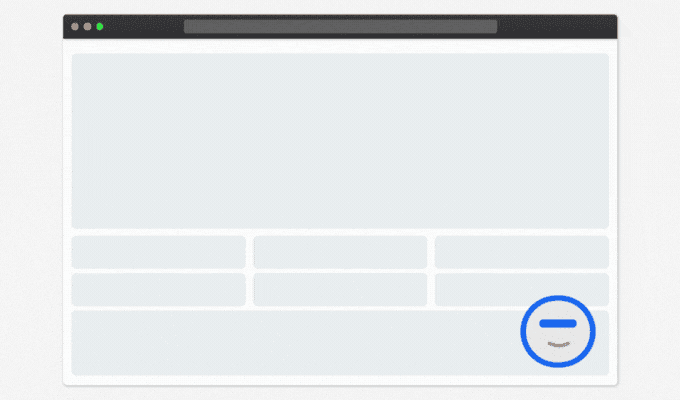
Since chatbots are built on the foundation of the instant messaging framework, they need to have the same features and feel. Emojis, images, and videos are a regular part of our conversations. Adding them to your chatbot transforms your bot from a mere bot to a bot with a little bit of personality.
The visual chatbot builder needs to have this option so you can be more expressive with your customers via your conversations. It also helps you break the ice with your prospects.
Incorporating these files also allow you to present your products or services in carousels. It reduces clutters on your chat interface and shows your offering in a presentable way.
8. Human Handover
Conversational marketing accumulates bot and live agent support. You cannot just have one and not have the other. While bots are evolving with each day, they still have limitations in terms of solving complex customer problems.
Be it rule-based bots or AI bots, a lot of times the bot fails to understand the user's request and ends up frustrating the user. Or sometimes the user would prefer to speak to an agent directly. Or would need to address a complex issue urgently.
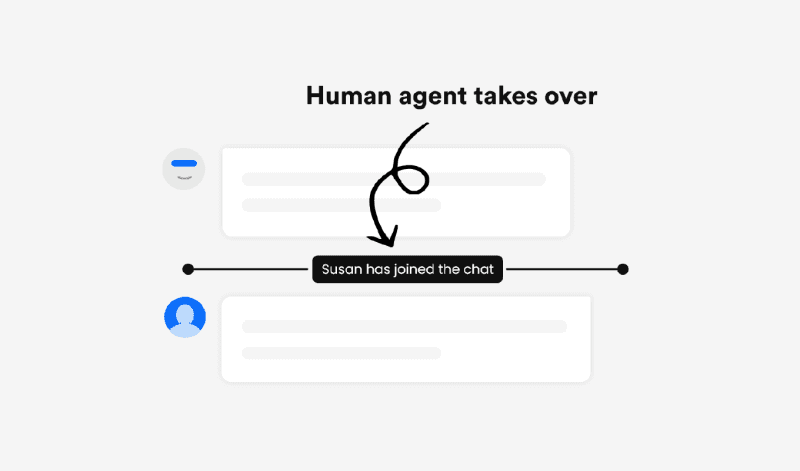
In any case, customers need an option to speak to a live agent and your chatbot needs to facilitate an option where it can rope in an agent whenever needed. A human handover option inside a visual chatbot builder shifts the conversation from an automated chat to one with an agent.
This chatbot builder feature will allow you to provide support regardless of the bot limitations and complexity of the issues and elevate your overall customer experience.
9. Conditional Branching
Not all your visitors will follow the same conversational path. Conditional branching helps you navigate visitors in a conversational flow based on predetermined criteria. Depending on the visitor’s response, you can program your bot to skip a certain action or perform another action like contact you or check for a live agent.
For example, you can send visitors to a different flow based on a ‘yes’ or ‘no’ answer. The different triggers (such as equals, not equals, and values that take the relevant flow forward) that you add to the visual chatbot builder will help you tailor the conversational experiences of the users based on the information they provide.
This doesn’t entirely mean you change the content that your visitor sees but it does give you the liberty to adjust the tone of voice and use specific expressions.
Along with the features that we have discussed so far, you should also look for some important integrations in a chatbot builder.
II. 4 Must-have Integrations
A chatbot is a mix of many integrations — add-ons that enhance the performance and help you achieve your chatbot KPIs. Check for native integrations on a chatbot. While what kind of integrations you need depends on your use cases and industries, there are some basic must-haves which are:
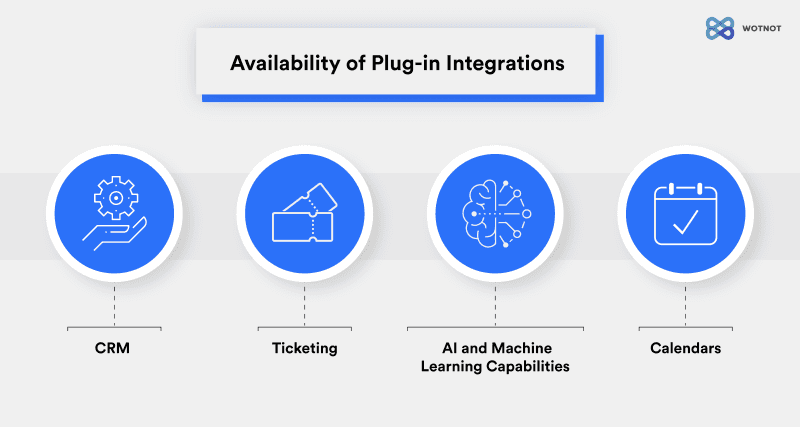
1. CRM
Since a chatbot generates leads from website visitors, you need to integrate your chatbot with your CRM like Salesforce and HubSpot where the leads ultimately get stored. It helps you get a unified view of your leads and their conversational history.
2. Ticketing
A ticketing integration like Zendesk, Help Scout, or Freshdesk will allow you to collect support tickets from your chatbot and store them in your customer support database.
3. AI and Machine Learning Integrations
Having a chatbot with AI functionality has become a bare necessity because rule-based chatbots only fulfill limited objectives. If you want to have personalized conversations at scale, you need AI chatbots. AI chatbots are built on a no-code platform itself with an AI-powered knowledge base where you can create intents, utterances, and bot responses.
4. Calendars
Chatbots help you manage schedules. All you have to do is look for scheduling integrations like Google Calendar or Calendly. You can completely automate the appointments and booking process with these integrations. It also allows users to book appointments themselves, pointing at a higher lead commitment.
III. Value for Money
Lastly, apart from the features and integrations, you need to know if the chatbot builder fits into your budget and provides all the necessary applications that you’ll need.
One way to choose is to look for builders with freemium chatbot pricing models where you can choose from different pricing options depending on your business size and type.
For example, if you’re a mid-size business, then you can opt for WotNot’s business plan. You get access to the chatbot builder and the basic and advanced integrations that we discussed.
Make a list of your requirements and determine the budget and expected ROI before choosing a chatbot vendor. In any case, you’d want to optimize your costs and increase your revenue. And your chatbot builder should be able to do that for you.
Wrapping Up
There you have it — all the answers to your chatbot builder questions. A good chatbot builder is essential to your chatbot's success. It needs to provide the DIY framework so that you can independently implement the best practices in chatbot building.
All in all, chatbot building is fun and easier than you think. Don’t believe us? Sign up to WotNot to explore our bot builder and find out for yourself.
You can also contact our experts or schedule a demo for any query related to chatbot building.
ABOUT AUTHOR
Hardik Makadia
CEO, WotNot
His leadership, pioneering vision, and relentless drive to innovate and disrupt has made WotNot a major player in the industry.



